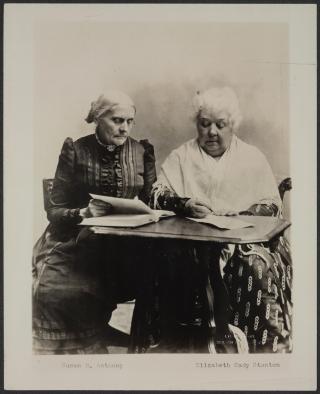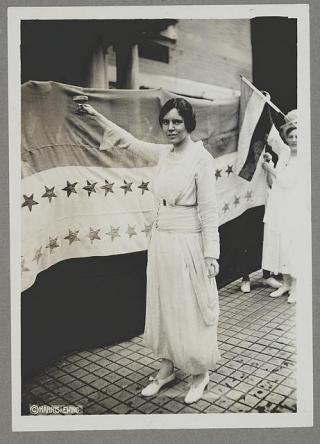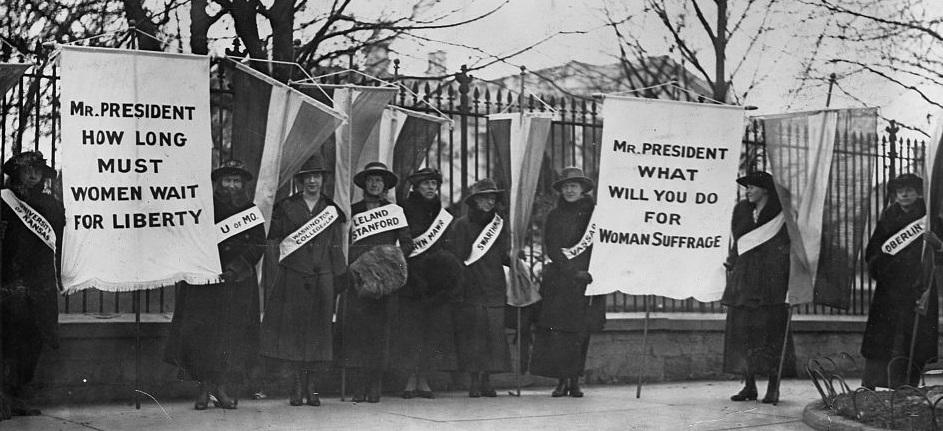The Woman Suffrage Movement
The Most Significant Achievement of Women in the Progressive Era

Susan B. Anthony (L) and Elizabeth Cady Stanton (R)
The woman suffrage movement actually began in 1848, when a women's rights convention was held in Seneca Falls, New York. The Seneca Falls meeting was not the first in support of women's rights, but suffragists later viewed it as the meeting that launched the suffrage movement. For the next 50 years, woman suffrage supporters worked to educate the public about the validity of woman suffrage. Under the leadership of Susan B. Anthony, Elizabeth Cady Stanton, and other women's rights pioneers, suffragists circulated petitions and lobbied Congress to pass a constitutional amendment to enfranchise women.
At the turn of the century, women reformers in the club movement and in the settlement house movement wanted to pass reform legislation. However, many politicians were unwilling to listen to a disenfranchised group. Thus, over time women began to realize that in order to achieve reform, they needed to win the right to vote. For these reasons, at the turn of the century, the woman suffrage movement became a mass movement.

In the 20th century leadership of the suffrage movement passed to two organizations. The first, the National American Woman Suffrage Association (NAWSA), under the leadership of Carrie Chapman Catt, was a moderate organization. The NAWSA undertook campaigns to enfranchise women in individual states, and simultaneously lobbied President Wilson and Congress to pass a woman suffrage Constitutional Amendment. In the 1910s, NAWSA's membership numbered in the millions.
The second group, the National Woman's Party (NWP), under the leadership of Alice Paul, was a more militant organization. The NWP undertook radical actions, including picketing the White House, in order to convince Wilson and Congress to pass a woman suffrage amendment.
In 1920, due to the combined efforts of the NAWSA and the NWP, the 19th Amendment, enfranchising women, was finally ratified. This victory is considered the most significant achievement of women in the Progressive Era. It was the single largest extension of democratic voting rights in our nation's history, and it was achieved peacefully, through democratic processes.

Credit
Library of Congress
College day in the picket line
Sources
- Cooney, Jr. Robert P.J. Winning the Vote: The Triumph of the American Woman Suffrage Movement. American Graphic Press, 2005.
- Frankel, Noralee and Nancy S. Dye, editors. Gender, Class, Race, and Reform in the Progressive Era. The University of Press of Kentucky, 1991.
- Ginzberg, Lori D. Women and the Work of Benevolence: Morality, Politics, and Class in the Nineteenth-Century United States. Yale University Press, 1990.
- Muncy, Robyn. Creating a Female Dominion in American Reform, 1890-1935. Oxford University Press, 1994.
- Muncy, Robyn. "Julia Clifford Lathrop." Women Building Chicago 1790-1990: A Biographical Dictionary. Rima Lunin Schultz and Adele Hast, editors. Indiana University Press, 2001. 490-2.
- Orleck, Annalise. Common Sense and a Little Fire: Women and Working-Class Politics in the United States, 1900-1965. University of North Carolina Press, 1995.
- Open Collections Program: Working Women, 1800-1930. Harvard University Library. http://ocp.hul.harvard.edu/ww/
- Rosenberg, Rosalind. Beyond Separate Spheres: Intellectual Roots of Modern Feminism. New Haven: Yale University Press, 1982.
- Scott, Anne Firor. "Most Invisible of All: Black Women's Voluntary Associations." The Journal of Southern History. Vol. LVI, No. 1, February 1990.
- Schneider, Dorothy and Carl J. Schneider. American Women in the Progressive Era, 1900-1920. Facts on File, Inc., 1993.
- Sklar, Kathryn Kish. Florence Kelley and the Nation's Work: The Rise of Women's Political Culture, 1830-1900. Yale University Press, 1995.




No comments:
Post a Comment